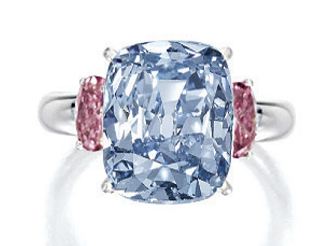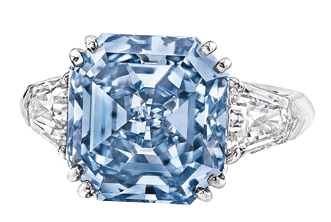Blue diamonds continue to bring top prices at auction, a natural blue diamond being so rare and so dazzling. A ring set with a 6.01-carat cushion-cut blue diamond, flanked by pink diamonds, went for $10 million at Sotheby’s Hong Kong in October and an 8.01-carat vivid blue emerald-cut diamond ring is expected to sell there for as much as $14 million in April.
6.01-carat (left) and 8.01-carat fancy vivid blue diamonds (Sotheby’s Hong Kong)
Both are lovely jewels – and I’m sure much lovelier in real life, the magic of diamonds being impossible to capture in still photos – but they don’t hold a candle to the most famous blues, most notably the Hope Diamond. What makes natural blue diamonds so rare and so… blue? Something very unglamorous: boron, the stuff you find in flares and nuclear reactors, not so much in diamonds.
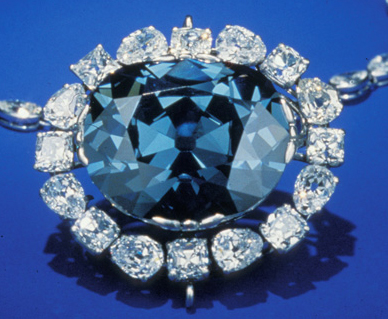
Happily for all of us, a couple of the rarest and most dazzling blue diamonds can be seen, free of charge, whenever you happen to be in Washington, D.C. And, when we’re not looking at them in the Smithsonian’s National Museum of Natural History, scientists can access them, in an endless effort to explain the phenomenon of blue diamonds.
They just performed another test on the Smithsonian’s blue treasures, including the Hope Diamond and the Blue Heart, to find out exactly why blue diamonds are blue. They knew it had something to do with the presence of boron, which is extremely rare in natural diamonds. Their question this time: Does the amount of boron in a blue diamond account for its color?
Every now and then, the Hope is removed from its display case and its 1910 Cartier setting, then inserted into various high-tech apparatuses, poked, prodded, and irradiated. But somehow it always defies analysis and ends up back in its showcase, mystery intact.
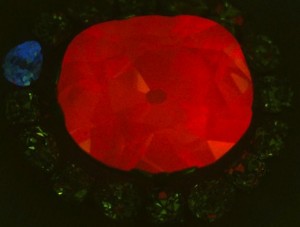
In 2010, for example, when the Hope shared the spotlight with the Wittelsbach-Graff, both historic gems were put under the microscope and exposed to infrared light. Both glowed brilliant red under ultraviolet light – though not in quite the same way. This bizarre ability of natural blue diamonds to emit a phosphorescent, glow-in-the-dark red, even after the light is turned off, is a tool gemologists use to separate real blue diamonds from fakes. Due to its particular boron mix, the Hope turns fiery red, as you can see in the photo at left.
Other tests were performed as well. Everyone, especially Laurence Graff who had just dropped $23.4 mil on the Wittelsbach, was hoping to discover they’d been cut from the same stone. Alas, while it was clear they’d been found around the same time (mid-17th century) and in close proximity in the Golconda mines of India, the famous diamonds were not, in fact, separated at birth.
Last month, after visiting hours were over and doors carefully locked, a local jeweler removed the Hope from its setting once again and four experts – Eloise Gaillou and Jeffrey Post of the Smithsonian, Detlef Rost of the University of Manchester, and James Butler of the Naval Research Laboratory in Washington DC – brought the Hope, the Blue Heart, and 76 other natural diamonds to the lab. One by one, they were inserted into an ion mass spectrometer which shaved off millions of atoms from tiny patches of each. These atoms were then sorted by weight. The goal: to discover how many of those atoms were boron.
Once again, the Hope glowed brilliant red under infrared light and proved to have an extremely high concentration of boron. While type Ia diamonds showed no detectable boron, natural type IIb blue diamonds such as the Hope and Blue Heart, revealed significantly higher amounts than previously reported. Not surprisingly, the Hope had the most by far: as much as 8.4 ppm in spots, compared to as little as .08 in other natural blue diamonds. And yet, the boron content of the blue diamonds did not, in the end, entirely explain the variety or depth of their color.
“The samples in this study are all gem-quality diamonds, including some Intense to Fancy-Deep blue diamonds; color intensity, however, only loosely correlates with the boron content,” reads the abstract published in American Mineralogist last month. “The exact nature of the phosphorescence processes is still not fully understood.”
When museum visitors arrived the next morning, the scientists were back in their offices scratching their heads, while the Hope spun slowly on her carousel, as though she’d never left. Someone probably trotted around the case like I always do, following it like a nail to a magnet and emitting mews of delight. If you’ve ever seen the real thing, you know it’s nothing like looking at the photos.
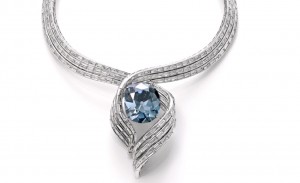
When I saw it last, it was out of its glitzy white-diamond Cartier setting. If you ask me, they should leave it in its unadorned, naked glory, but I guess we’re all accustomed to seeing it in that white diamond halo its been wearing for a century. They replaced that 1910 Cartier setting with a sleek Harry Winston design in 2010, but after a year on display, it’s back in its familiar setting and the Winston piece is being sold off with a different center stone, proceeds to benefit the Smithsonian.
I swear, looking at the Hope makes you feel drunk. What causes this giddy reaction? The color? The phosphorescent emissions? Scientists are pretty sure the boron content causes the phosphorescent emissions, but frankly, they just don’t know what causes that particular shade of blue. It’s officially described as “dark grayish blue” – same designation given to the Wittelsbach-Graff before Graff had it recut to “fancy deep blue.”
But while these terms mean something to gemologists, they don’t come close to capturing the reality. The Hope Diamond is the color of the ocean when you’re out really far, looking into miles and miles of water, Titanic deep. And from that dizzying blue come those full-spectrum rainbow sparkles of a really fine diamond. That is one giddy combination.
Scientific explanation? Frankly, they haven’t entirely figured it out, but you can be pretty sure they’ll keep trying. In the meantime, we all get to admire it and catch a free buzz. No admission or cocktails required.
Related posts:
Wittelsbach-Graff diamond debuts
Smithsonian jewels for the masses, courtesy QVC
Elizabeth Taylor auction and Elizabeth Taylor auction’s 12 world records

